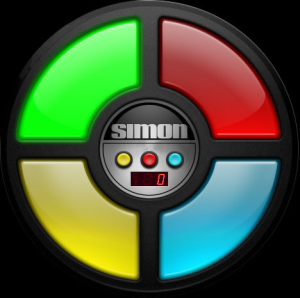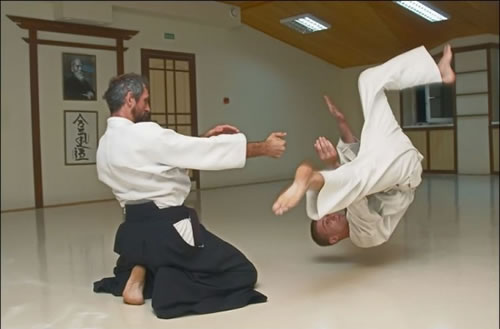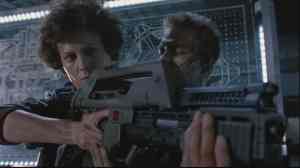This is one of my favorite screenshots of all time:

Elaborate by Dewski14
In one frame, this screenshot tells an epic tragedy worthy of Sophocles himself. Red Sniper, furious at Blue Man for stealing the attentions of his bride, Grenadina, confronts him in an alley behind the cathedral. After a heated exchange, the jilted lover fires a single shot at his rival, who ducks out of the way, and the hateful bullet ricochets into the heart of his beloved, who was hastening to tell them they were actually brothers, separated at birth. The story can be told because the causes and effects are so cearly linked; by exaggerating the causal relationships and drawing out their interactions, a confusing or seemingly random event can be transformed into a dramatic moment.
At a basic level, a game can be interactive only because it is a simulation, a systematic collection of cause and effect relationships. It doesn’t matter if the world being simulated is rigid shapes dropping into a well, a jungle teaming with Jurassic wildlife or a city populated with tiny citizens, it’s the cause and effect nature of a simulation that allows players to make predictions, develop skills and play the game. Some game simulations have explicit causal relationships. “If you pass “Go” then collect $200 from the bank.” Others try to approximate the real world, including the complex cause and effect events, with more or less success. Unfortunately, the connections between causes and effects that are obvious in the real world are often difficult to track in a game, making them unnecessarily hard to understand and master.

The "Where the %@$# Am I Getting Shot From?!" Effect
Linking Cause and Effect
The best way to increase the intelligibility of your simulation is to increase the strength of the link between cause and effect in the player’s mind.
Don’t Poke the Lizard Brain. The human brain is not like a computer; it doesn’t have a lot of computational horsepower that can be applied to arbitrary problems. What it does have are highly specialized neural circuits designed to perform a single task very efficiently. Just like your graphics card is specifically made to render 3d scenes, there are parts of your brain devoted to almost every function you need to operate in your daily life. There are circuits for determining the direction a sound is coming from, circuits for reading the emotions behind facial expressions, circuits that use shading to determine the shape of an object, circuits for predicting the path of a falling object, and countless other abilities we rarely notice we have. The problem is, these circuits are so finely tuned for reality that the slightest deviation in a game simulation disorients them, destroying the player’s suspension of disbelief.
So, if a grenade explosion sounds like it is coming from the wrong place, players won’t understand that the grenade is what killed them. If a character’s mouth doesn’t move right, instead of conveying the emotion of a scene they enter the uncanny valley. If the lighting on an object is incorrect, or the physics system doesn’t make it behave accurately, players will not be able to predict how it will move or how they should react. If players are constantly confused by what is happening and unable to describe the cause and effect relationships in a game, it is often because the simulation is off, even by a small amount, and must be tuned properly.
Create a Visual Connection. The connection between cause and effect can be reinforced with simple visual elements. If a blue-green gun fires a blue-green projectile that explodes with a blue-green explosion that leaves a blue-green decal and causes the player’s screen to flash blue-green, they will probably be able to connect the dots. Another technique is to conserve the momentum of the cause in the effect, so if the player is melee attacked by an enemy charging from the right, throwing their body to the left in the direction of the attack helps link them in the player’s mind. If a certain spell causes an enemy to become confused, use the same little stars on the spell icon that are circling the confused enemy’s head. If one character is using mind controlling powers on another, actually draw visible waves of telepathic force between them. If an ancient artifact slows down anyone standing within 20 feet of it, attach a visible effect that extends 20 feet to indicate the range.
Avoid False Causes. It is also important to avoid creating false connections in the player’s mind between unrelated events. Entire lobes of your brain are devoted to finding patterns, and sometimes the unfamiliar experience of playing a game puts them into overdrive and your mind doesn’t just recognize patterns, it invents them. “I swear, every time I hear the sound of the timpani in the background music, I take damage. I must find a way destroy the percussion section!” Often these coincidental connections are difficult to predict, but they can be avoided by removing superfluous sounds, effects or actions that are not related to any game mechanic. Fires or explosions that are purely for dramatic effect, but can’t actually hurt the player. Enemy animations that look significant, but are actually just random variations on a walk cycle. Environmental features that stand out, like switches or doors, but are merely cosmetic. All of these are prime candidates for false causes.
Temporal Separation. One of the most effective ways to help players connect a cause to an effect is by slowing it down. If a grenade causes a vehicle to explode, delay the second explosion by a fraction of a second. If flipping a switch causes a gate to open, slow it down so the gate takes several seconds to open completely. If a headshot does more damage to an enemy, exaggerate and elongate their reaction so it is clear that something unusual is happening. These delays and exaggerations help the player perceive the two events as separate and sequential steps in a process. When two events are simultaneous, it is difficult to tell which one is the cause and which the effect, or even if they are related at all. But a repeated sequence of events is easily recognized and understood.

Call of Duty's Kill Cam delays and replays the cause of your death
Add Intermediate Steps. If I punch my younger brother and all the sudden I can’t sit down without wincing, I am unlikely to connect the two events. However, if punch my younger brother, and then my Mom yells at me, and then I have to wait for my Dad to come home, and then I have to go get the leather belt from his closet, and then bring it back and “assume the position” I will probably learn the cause and effect connection. At least after the first few dozen times. Sometimes, the easiest way to make a connection more noticeable is by adding intermediate steps to the sequence. Two events happening in the same order might just be random coincidence. Five events happening the same way every time is probably not.
Exaggerating causal connections not only helps players learn how to play a game, but it increases the dramatic context of their actions. It will allow them to construct stories instead of just experiencing a series of events. And it will make the game more appealing to people that are just watching a video on YouTube, drawing in new players.
























